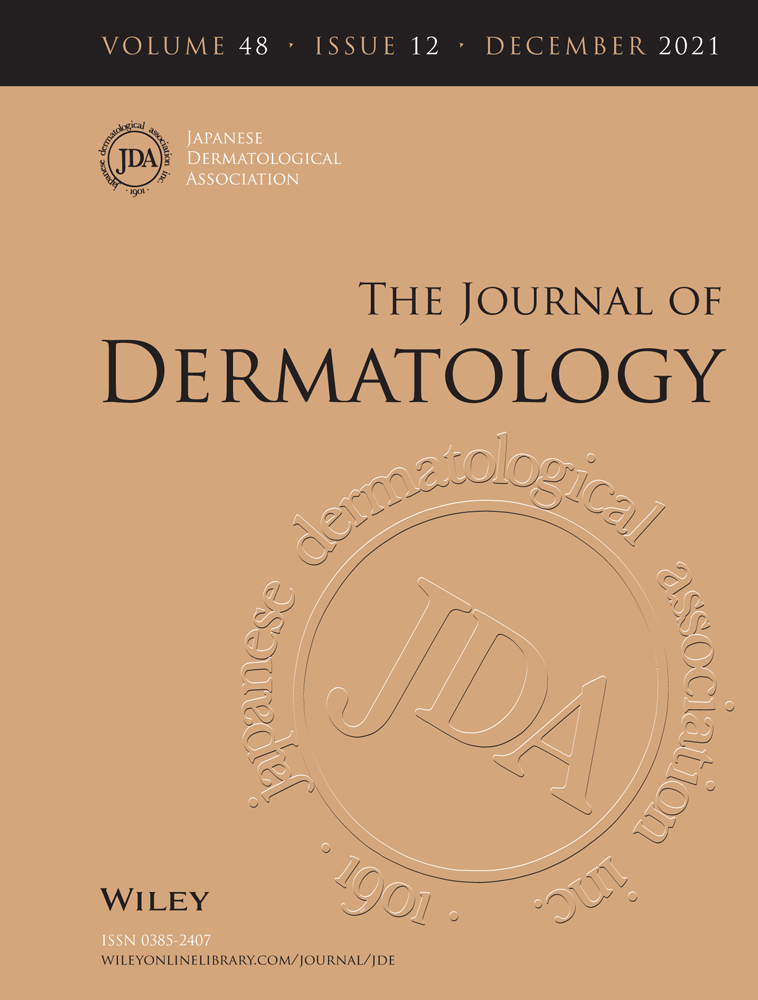LETTER TO THE EDITOR
Novel nonsense mutation in the SLC39A4 gene in a Japanese boy with mild acrodermatitis enteropathica
Naohisa Ichiki,
Corresponding Author
Naohisa Ichiki
Department of Dermatology, Gifu University Graduate School of Medicine, Gifu, Japan
Correspondence
Naohisa Ichiki, Gifu University Graduate School of Medicine, 1-1 Yanagido, Gifu-shi, Gifu 501-1194, Japan.
Email: [email protected]
Search for more papers by this author Chisato Tawada,
Chisato Tawada
Department of Dermatology, Gifu University Graduate School of Medicine, Gifu, Japan
Search for more papers by this author Zenichiro Kato,
Zenichiro Kato
Department of Pediatrics, Gifu University Graduate School of Medicine, Gifu, Japan
Search for more papers by this author Hajime Nakano,
Hajime Nakano
Department of Dermatology, Hirosaki University Graduate School of Medicine, Gifu, Japan
Search for more papers by this author Mariko Seishima,
Mariko Seishima
Department of Dermatology, Gifu University Graduate School of Medicine, Gifu, Japan
Search for more papers by this author
Naohisa Ichiki,
Corresponding Author
Naohisa Ichiki
Department of Dermatology, Gifu University Graduate School of Medicine, Gifu, Japan
Correspondence
Naohisa Ichiki, Gifu University Graduate School of Medicine, 1-1 Yanagido, Gifu-shi, Gifu 501-1194, Japan.
Email: [email protected]
Search for more papers by this author Chisato Tawada,
Chisato Tawada
Department of Dermatology, Gifu University Graduate School of Medicine, Gifu, Japan
Search for more papers by this author Zenichiro Kato,
Zenichiro Kato
Department of Pediatrics, Gifu University Graduate School of Medicine, Gifu, Japan
Search for more papers by this author Hajime Nakano,
Hajime Nakano
Department of Dermatology, Hirosaki University Graduate School of Medicine, Gifu, Japan
Search for more papers by this author Mariko Seishima,
Mariko Seishima
Department of Dermatology, Gifu University Graduate School of Medicine, Gifu, Japan
Search for more papers by this author
First published: 08 October 2021
No abstract is available for this article.
CONFLICT OF INTEREST
None declared.
REFERENCES
- 1Zhong W, Yang C, Zhu L, Huang Y-Q, Chen Y-F. Analysis of the relationship between the mutation site of the SLC39A4 gene and acrodermatitis enteropathica by reporting a rare Chinese twin: a case report and review of the literature. BMC Pediatr. 2020; 20: 34.
- 2Nakano A, Nakano H, Toyomaki Y, Hanada K, Nomura K. Novel SLC39A4 mutations in acrodermatitis enteropathica. J Invest Dermatol. 2003; 120: 963–6.
- 3Küry S, Kharfi M, Kamoun R, Taïeb A, Mallet E, Baudon JJ, et al. Mutation spectrum of human SLC39A4 in a panel of patients with acrodermatitis enteropathica. Hum Mutat. 2003; 22: 337–8.
- 4Meftah SP, Kuivaniemi H, Tromp G, Kerkeni A, Sfar MT, Ayadi A, et al. A new mutation in exon 3 of the SCL39A4 gene in a Tunisian family with severe acrodermatitis enteropathica. Nutrition. 2006; 10: 1067–70.
- 5Zhou X-Y, Chen X-J, Wang S, Xue J, Liu W, Wang Q, et al. One recurrent homozygous mutation of SLC39A4 in a girl with acrodermatitis enteropathica from southwestern China. Int J Dermatol. 2014; 55: 223–5.




